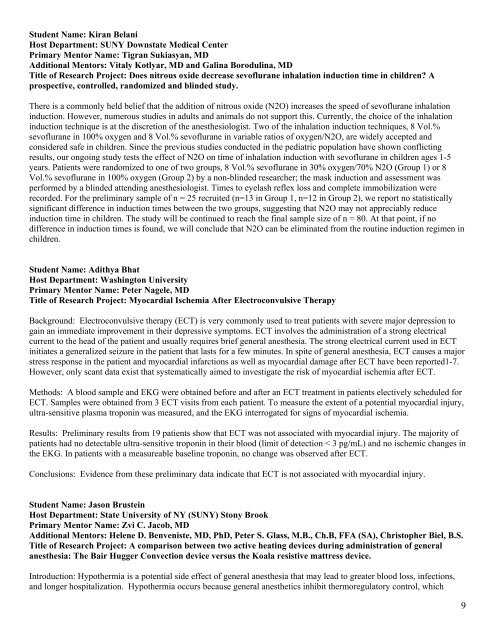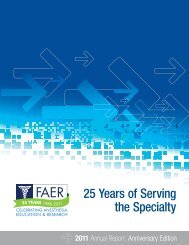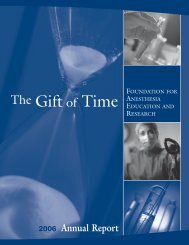2010 MSARF Symposium Participants - Foundation for Anesthesia ...
2010 MSARF Symposium Participants - Foundation for Anesthesia ...
2010 MSARF Symposium Participants - Foundation for Anesthesia ...
Create successful ePaper yourself
Turn your PDF publications into a flip-book with our unique Google optimized e-Paper software.
Student Name: Kiran Belani<br />
Host Department: SUNY Downstate Medical Center<br />
Primary Mentor Name: Tigran Sukiasyan, MD<br />
Additional Mentors: Vitaly Kotlyar, MD and Galina Borodulina, MD<br />
Title of Research Project: Does nitrous oxide decrease sevoflurane inhalation induction time in children? A<br />
prospective, controlled, randomized and blinded study.<br />
There is a commonly held belief that the addition of nitrous oxide (N2O) increases the speed of sevoflurane inhalation<br />
induction. However, numerous studies in adults and animals do not support this. Currently, the choice of the inhalation<br />
induction technique is at the discretion of the anesthesiologist. Two of the inhalation induction techniques, 8 Vol.%<br />
sevoflurane in 100% oxygen and 8 Vol.% sevoflurane in variable ratios of oxygen/N2O, are widely accepted and<br />
considered safe in children. Since the previous studies conducted in the pediatric population have shown conflicting<br />
results, our ongoing study tests the effect of N2O on time of inhalation induction with sevoflurane in children ages 1-5<br />
years. Patients were randomized to one of two groups, 8 Vol.% sevoflurane in 30% oxygen/70% N2O (Group 1) or 8<br />
Vol.% sevoflurane in 100% oxygen (Group 2) by a non-blinded researcher; the mask induction and assessment was<br />
per<strong>for</strong>med by a blinded attending anesthesiologist. Times to eyelash reflex loss and complete immobilization were<br />
recorded. For the preliminary sample of n = 25 recruited (n=13 in Group 1, n=12 in Group 2), we report no statistically<br />
significant difference in induction times between the two groups, suggesting that N2O may not appreciably reduce<br />
induction time in children. The study will be continued to reach the final sample size of n = 80. At that point, if no<br />
difference in induction times is found, we will conclude that N2O can be eliminated from the routine induction regimen in<br />
children.<br />
Student Name: Adithya Bhat<br />
Host Department: Washington University<br />
Primary Mentor Name: Peter Nagele, MD<br />
Title of Research Project: Myocardial Ischemia After Electroconvulsive Therapy<br />
Background: Electroconvulsive therapy (ECT) is very commonly used to treat patients with severe major depression to<br />
gain an immediate improvement in their depressive symptoms. ECT involves the administration of a strong electrical<br />
current to the head of the patient and usually requires brief general anesthesia. The strong electrical current used in ECT<br />
initiates a generalized seizure in the patient that lasts <strong>for</strong> a few minutes. In spite of general anesthesia, ECT causes a major<br />
stress response in the patient and myocardial infarctions as well as myocardial damage after ECT have been reported1-7.<br />
However, only scant data exist that systematically aimed to investigate the risk of myocardial ischemia after ECT.<br />
Methods: A blood sample and EKG were obtained be<strong>for</strong>e and after an ECT treatment in patients electively scheduled <strong>for</strong><br />
ECT. Samples were obtained from 3 ECT visits from each patient. To measure the extent of a potential myocardial injury,<br />
ultra-sensitive plasma troponin was measured, and the EKG interrogated <strong>for</strong> signs of myocardial ischemia.<br />
Results: Preliminary results from 19 patients show that ECT was not associated with myocardial injury. The majority of<br />
patients had no detectable ultra-sensitive troponin in their blood (limit of detection < 3 pg/mL) and no ischemic changes in<br />
the EKG. In patients with a measureable baseline troponin, no change was observed after ECT.<br />
Conclusions: Evidence from these preliminary data indicate that ECT is not associated with myocardial injury.<br />
Student Name: Jason Brustein<br />
Host Department: State University of NY (SUNY) Stony Brook<br />
Primary Mentor Name: Zvi C. Jacob, MD<br />
Additional Mentors: Helene D. Benveniste, MD, PhD, Peter S. Glass, M.B., Ch.B, FFA (SA), Christopher Biel, B.S.<br />
Title of Research Project: A comparison between two active heating devices during administration of general<br />
anesthesia: The Bair Hugger Convection device versus the Koala resistive mattress device.<br />
Introduction: Hypothermia is a potential side effect of general anesthesia that may lead to greater blood loss, infections,<br />
and longer hospitalization. Hypothermia occurs because general anesthetics inhibit thermoregulatory control, which<br />
9





